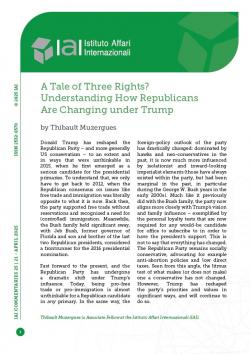A Tale of Three Rights? Understanding How Republicans Are Changing under Trump
Donald Trump has reshaped the Republican Party – and more generally US conservatism – to an extent and in ways that were unthinkable in 2015, when he first emerged as a serious candidate for the presidential primaries. To understand that, we only have to get back to 2012, when the Republican consensus on issues like free trade and immigration was literally opposite to what it is now. Back then, the party supported free trade without reservations and recognised a need for (controlled) immigration. Meanwhile, the Bush family held significant sway, with Jeb Bush, former governor of Florida and son and brother of the last two Republican presidents, considered a frontrunner for the 2016 presidential nomination.
Fast forward to the present, and the Republican Party has undergone a dramatic shift under Trump’s influence. Today, being pro-free trade or pro-immigration is almost unthinkable for a Republican candidate in any primary. In the same way, the foreign-policy outlook of the party has drastically changed: dominated by hawks and neo-conservatives in the past, it is now much more influenced by isolationist and inward-looking imperialist elements (those have always existed within the party, but had been marginal in the past, in particular during the George W. Bush years in the early 2000s). Much like it previously did with the Bush family, the party now aligns more closely with Trump’s vision and family influence – exemplified by the personal loyalty tests that are now required for any would-be candidate for office to subscribe to in order to have the president’s support. This is not to say that everything has changed. The Republican Party remains socially conservative, advocating for example anti-abortion policies and low direct taxes. Seen from this angle, the litmus test of what makes (or does not make) one a conservative has not changed. However, Trump has reshaped the party’s priorities and values in significant ways, and will continue to do so.
The Republican Party that emerged from the 2024 elections is distinct from the one that lost in 2020 or won the trifecta – presidency, Senate and House – in 2016. To outsiders, especially Europeans, Trumpism may appear as a monolithic structure, an image Trump has sometimes reinforced. However, the US president’s success (and popularity) lies in managing a coalition of diverse interests and ideologies. Trump’s coalition includes disparate groups like tech entrepreneurs from Silicon Valley looking forward to a bright future and former steel workers in Youngstown Ohio, looking back with nostalgia to a past that they would like to re-create. Some members of this coalition are organising and seek to apply an ideological lens to Trump’s instincts, in order to define the future of Trumpism beyond the current presidency.
It is therefore extremely important to understand how the current Trumpian coalition functions – if we then want to understand where it is headed. Currently, the coalition ruling the party can be divided into three main groups: MAGA-World, the tech-libertarians, and the Country-Club Republicans.
The ideological core: MAGA-World
MAGA-World, currently the strongest faction (and the most ideologically aligned with Trump’s instincts), comprises the first converts to Trumpism. This group is itself diverse in terms of vision and objectives. It includes religious conservatives, both Protestant evangelicals and conservative Catholics, traditional antifederalists who oppose federal institutions with cultural influence, and anti-liberals who view Trump as an opportunity to implement a reactionary revolution.
MAGA-World’s general view can be characterised as illiberal (that is, authoritarian-leaning) – or, to use their own terminology, post-liberal. Its supporters believe that liberalism has failed, and seek to recreate an order based on traditional values – something that involves an active participation (even at times coercion) from the state, and also includes forcing a changing of the elites (a “regime change”, as political theorist and liberalism-critic Patrick Deneen puts it). They aim to return to a perceived golden age, the dating of which varies: 1968, the high point of the left-liberal era with Lyndon Johnson’s welfare programmes and civil rights laws and the rise of the New Left; 1917, when the US entry into World War I inaugurated the century of America’s engagement in global affairs; and even 1789, when the federalist Constitution replaced the Articles of Confederation as the founding document of the nation. Each of these dates is often used as marking the beginning of the decline, therefore setting the objectives for where and until which point to turn back the clock.
The MAGA movement’s ideology is evident in the Trump administration’s policies, such as the use of tariffs to rebuild the US industrial base and provide revenue to compensate for reductions of (or sometimes even replace) the income tax, as was the case before 1917. MAGA-World advocates for a strong, interventionist state to promote traditional morals and combat “wokeism”.
In foreign policy, MAGA-World is not isolationist – in fact, it is imperialistic within the Americas, seeking to expel Chinese influence from the Western Hemisphere, and even entertaining the idea of annexing Canada and Greenland. This vision is directly inspired by the policies of President William McKinley (1897-1901), a champion of protectionism and American territorial expansion to the Philippines, Panama and (indirectly) Cuba.
MAGA-World has developed its own ecosystem, including think tanks like the America-First Foundation and the Claremont Institute, which provide programmatic substance to Trumpism. Intellectuals like Deneen and Stephen Wolfe, along with legal theorists like Adrian Vermeule, contribute to the movement’s intellectual foundation.
The New Kids on the Block: The techno-libertarians
The techno-libertarians offer a different, forward-looking vision, emphasising technology as a solution to humanity’s problems. They combine radical capitalism with a fascination for technology and social determinism, sometimes bordering on social Darwinism. Many techno-libertarians are venture capitalists from Silicon Valley who support Trump to promote what they conceive as a free and open Internet.
Techno-libertarians are sceptical or openly critical of liberal democracy, preferring direct forms of democracy enabled by social media or even oligarchic structures enabled by the concentration of power in a few technological giants. They support populist and authoritarian candidates in Europe (where many of them have specific private interests) and thus have a more global foreign policy outlook than MAGA-World, not only limited to the question of the Americas.
Key figures in the techno-libertarian movement include venture capitalist Marc Andreessen, blogger Curtis Yarvin (co-founder of the anti-democratic and anti-liberal Dark Enlightenment movement), Palantir’s CEO Peter Thiel and obviously Elon Musk. They may have very different policy solutions, but all advocate for a future where technology solves societal problems and opens new frontiers, such as colonising Mars or enhancing human capabilities – for them, the state is a hindrance to that development, and should let them free to reach out for the stars.
Like MAGA-world, the techno-libertarian movement is diverse, including less ideological elements, and also some more left-leaning individuals. Many of its representatives have voted Democrat in the past but have parted ways with the left due to perceived over-regulation and wokeism.
Regulation is the most significant issue for techno-libertarians, who support Trump to re-establish their dream of a totally free and open Internet (and beyond, society) – or actually, one that would be free for them to shape. They view themselves as “free speech absolutists”, but do not hesitate to use their financial power to manipulate algorithms on social media to push their narratives.
Still hanging there: The Country Club Republicans
Country Club Republicans represent the traditional conservative base since Ronald Reagan (1981-89). They support Trump because he wins elections and delivers on his promises, such as nominating conservative judges, securing the Southern border and reducing government spending (something that his predecessors did not necessarily do). However, they are critical of Trump’s more radical changes, like the shift in foreign policy and the use of tariffs.
Country Club Republicans view America as a “shining city on the hill” and support engagement in global affairs, particularly in countering China. They are sceptical of the rapprochement with Russia and the dismantling of the US Agency for International Development (USAID) but they do appreciate Trump’s efforts to reduce government spending – the dismantlement of the Department of Education, a promise made by Republican candidates in 1981, has been particularly popular among that base.
This group lacks strong leadership and a unified vision, making them the weakest link in the Trump coalition. They are unlikely to speak out against Trump’s policies publicly (at least for now), fearing challenges in primaries and the potential loss of electoral support. While this may change as the economy is hitting its first major speed bumps following the US president’s tariffs, Country Club Republicans understand Trump’s moves as a corrective against free-market fundamentalism, which they believe has contributed to setting China on the road to challenge US economic and industrial primacy.
Looking at the future
Over the past decade, Trump has transformed US conservatism, with the emergence of the anti-liberal MAGA movement as a defining feature – so much so that the first hundred days of the current administration is in many ways a MAGA-baby. The techno-libertarian wing is also rising, providing an optimistic (whether one considers it utopian or dystopian) vision for the future that contrasts with MAGA’s “American carnage” apocalyptic vision. The traditional wing of the party, the Country Club Republicans, will likely continue to support Trump, but their fortunes will depend on the economic and electoral outcomes of his administration.
That being said, one should not bet on these families to fall out, even in case of major difficulties for the Trump administration. It is way too early in Trump’s second term to see that, and many shared interests and solidarity remain within Republican ranks. The mid-term elections will be crucial in shaping the future, not only of the Trump administration, but also for the party as a whole, as they will define the importance of each family inside the coalition. Success will mean a strengthening of MAGA (and potentially the techno-libertarians, who will provide the funds), while defeat will most certainly give the initiative back to the Country-Club Republicans.
The main question remains as to what the traditional wing of the party will do in the next few years. Will they remain true to Donald Trump in the face of potential economic or diplomatic difficulties? Will they try to push and moderate the president’s worst instincts? Or will they revolt against MAGA if the tariffs turn out to be a disaster for the US economy? Much will depend on the immediate results of the Trump administration, both in terms of the economy (over the next six months) and electoral outcomes, especially in 2026. These, however, are long-term developments, and the rest of the world does not have that much time to get to grips with its relation with the Trump administration.
Thibault Muzergues is Associate Fellow at the Istituto Affari Internazionali (IAI).
-
Details
Rome, IAI, April 2025, 5 p. -
In:
-
Issue
25|21



